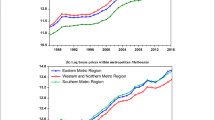Abstract
This paper explores the links between a strategic policy, urban consolidation, and house prices by examining the changes in the mix of housing and in house price for the period 1991–2004. We contend that urban consolidation could be seen as a source of additional supply, (which might be expected to be felt in lower prices and so contribute to a local policy objective) but also as a stimulus to demand (by developers who could bid up the price of lots where it was understood more housing could be built). Analyses were carried out at the metropolitan and sub-regional scales using correlation tests. The research finds very weak statistical connections, and concludes that this policy has not been associated with price changes.



Similar content being viewed by others
References
Anselin, L. (1995). Local Indicators of Spatial Association-LISA. Geographical Analysis, 27(2), 93–115.
Bourassa, S., Hamelink, F., Hoesli, M., & MacGregor, B. (1999). Defining housing submarkets. Journal of Housing Economics, 8, 160–183. doi:10.1006/jhec.1999.0246.
Han, S. S. (2004). Spatial structure of residential property value distribution in Beijing and Jakarta. Environment & Planning A, 36(7), 1259–1283. doi:10.1068/a36147.
Han, S. S. (2005). Polycentric urban development and spatial clustering of condominium property values: Singapore in the 1990s. Environment & Planning A, 37(3), 463–481. doi:10.1068/a3746.
Lusht, K. M. (1997). Real estate valuation: Principles and applications. New York: Irwin.
MacLennan, D., Munro, M., & Wood, G. (1987). Housing choice and the structure of the housing sub market. In B. Turner, J. Kemeny, & L. Lundquist (Eds.), Between state and market housing in the post industrial era (pp. 26–51). Stockholm: Almquist and Wicksell.
MacLennan, D., & Tu, Y. (1996). The micro economics of local housing market structure. Housing Studies, 11, 387–406. doi:10.1080/02673039608720864.
O’Connor, K., & Healy, E. (2002) Labour market, housing market interdependence within metropolitan Australia: A case study of Melbourne. Final Report Project 50024. Australian Housing and Urban Research Institute. http://www.ahuri.edu.au/publications/projects/p50024.
Pendall, R., Martin, J., & Fulton, W. (2002) Holding the line: Urban containment in the United States. A discussion paper prepared for The Brookings Institution Center on Urban and Metropolitan Policy.
Smith, F. H. (2003). Historical evidence on the monocentric urban model: A case study of Cleveland, 1915–1980. Applied Economics Letters, 10, 729–731. doi:10.1080/1350485032000133363.
Watkins, C. A. (2001). The definition and identification of housing submarkets. Environment & Planning A, 33, 2235–2253. doi:10.1068/a34162.
Author information
Authors and Affiliations
Corresponding author
Rights and permissions
About this article
Cite this article
Han, S.S., O’Connor, K. Urban consolidation and house prices: a case study of Melbourne 1990–2004. GeoJournal 73, 285–295 (2008). https://doi.org/10.1007/s10708-008-9199-8
Received:
Accepted:
Published:
Issue Date:
DOI: https://doi.org/10.1007/s10708-008-9199-8




